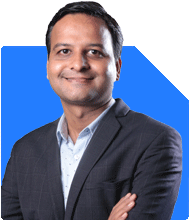Ramalingam Kalirajan |10908 Answers |Ask -Follow
Mutual Funds, Financial Planning Expert - Answered on Jun 01, 2024
He has an MBA in finance from the University of Madras and is a certified financial planner.
He is the director and chief financial planner at Holistic Investment, a Chennai-based firm that offers financial planning and wealth management advice.... more

Hello sir I'm 28 rights now and I want to invest 50K in Mutual Fund & 2000 SIP, Please Suggest Which fund Best for MF and SIP.
Since there's no one-size-fits-all answer in investing, let's discuss some factors to consider to pick the right mutual funds (MFs) and SIP for you:
1. Investment Goals:
What are you saving for? A down payment on a house, retirement, a dream vacation? Different goals have different time horizons, which affect your investment choices.
2. Risk Tolerance:
How comfortable are you with market ups and downs? Some MFs invest in stocks that can be more volatile, while others focus on bonds that are typically steadier.
3. Investment Timeframe:
When will you need the money? Long-term goals (10+ years) allow for taking on more risk to potentially achieve higher returns.
Investing in mutual funds can be a powerful tool for financial growth. Your goal is to invest Rs. 50,000 in a mutual fund and Rs. 2,000 monthly through a Systematic Investment Plan (SIP). Let’s explore the best strategies for you.
The Importance of Diversification
Diversification reduces risk by spreading your investments across various assets. Mutual funds offer diversification, allowing you to invest in a mix of stocks, bonds, and other securities. This balanced approach can help achieve your financial goals.
Choosing the Right Mutual Fund
When selecting a mutual fund, consider factors like your risk tolerance, investment horizon, and financial goals. Equity funds, debt funds, and hybrid funds offer different benefits. Equity funds have higher risk and return potential, debt funds offer stability, and hybrid funds provide a balanced approach.
Equity Funds for Long-Term Growth
Equity funds invest in stocks and are ideal for long-term growth. They can generate high returns over time but come with higher risk. If you are comfortable with market fluctuations, equity funds can be a good choice.
Debt Funds for Stability
Debt funds invest in fixed-income securities like bonds. They provide stable returns with lower risk compared to equity funds. Debt funds are suitable if you prefer a conservative approach and want steady income.
Hybrid Funds for Balance
Hybrid funds invest in a mix of equity and debt. They offer a balanced approach, reducing risk while providing growth potential. Hybrid funds are suitable if you seek moderate risk and balanced returns.
Systematic Investment Plan (SIP)
SIP allows you to invest a fixed amount regularly, promoting disciplined saving. Investing Rs. 2,000 monthly through SIP can help you build wealth over time. It mitigates market volatility through rupee cost averaging.
Benefits of SIP
SIP offers several benefits, including disciplined investing, convenience, and flexibility. It helps in building a habit of regular saving and investing. SIP also benefits from the power of compounding, enhancing long-term returns.
Evaluating Fund Performance
When choosing funds, evaluate their past performance, expense ratio, and fund manager’s expertise. Consistent performance over time indicates reliability. A lower expense ratio ensures more of your money is invested rather than spent on fees.
Role of Fund Manager
A skilled fund manager can significantly impact the fund’s performance. Look for funds managed by experienced professionals with a good track record. Their expertise can help in making informed investment decisions.
Understanding Expense Ratio
Expense ratio reflects the cost of managing the fund. A lower expense ratio means higher returns for you. Compare the expense ratios of different funds to make cost-effective choices.
Risk Assessment
Understanding your risk tolerance is crucial. Assess how comfortable you are with potential losses. High-risk funds can offer higher returns, but consider your financial stability and long-term goals.
Investment Horizon
Your investment horizon impacts fund selection. For long-term goals, equity funds can be suitable. For short-term goals, consider debt or hybrid funds. Align your investments with your time frame.
Importance of Regular Review
Regularly reviewing your investment portfolio ensures it stays aligned with your goals. Monitor fund performance and make adjustments as needed. This proactive approach helps in optimizing returns.
Advantages of Actively Managed Funds
Actively managed funds aim to outperform the market through strategic investments. Fund managers use research and analysis to make informed decisions. They can adapt to market conditions, potentially providing better returns.
Disadvantages of Index Funds
Index funds track a market index and lack active management. They may underperform in volatile markets as they cannot adjust holdings. Actively managed funds offer better growth opportunities through strategic management.
Benefits of Regular Funds
Investing through a Certified Financial Planner (CFP) offers guidance and expertise. Regular funds, managed by professionals, ensure informed decisions. CFPs help in selecting suitable funds, optimizing your investment strategy.
Disadvantages of Direct Funds
Direct funds require investors to make decisions without professional guidance. This can be challenging for those without market knowledge. Regular funds through CFPs provide expert advice, enhancing investment outcomes.
Personalized Investment Strategy
Creating a personalized investment strategy involves understanding your financial situation and goals. A CFP can help tailor a plan that suits your needs. This approach ensures your investments align with your objectives.
Market Trends and Analysis
Staying informed about market trends helps in making better investment decisions. A CFP can provide insights and analysis, guiding you through market changes. This expertise enhances your investment strategy.
The Role of Financial Education
Understanding financial concepts is crucial for making informed decisions. Educate yourself about mutual funds, SIPs, and market dynamics. Knowledge empowers you to take control of your financial future.
Building a Strong Financial Foundation
Investing in mutual funds and SIPs helps in building a strong financial foundation. It promotes disciplined saving, diversification, and long-term growth. A well-structured investment plan supports your financial goals.
Final Thoughts
Investing in mutual funds and SIPs can significantly enhance your financial growth. Choose funds based on your risk tolerance, investment horizon, and financial goals. Regularly review your portfolio and seek guidance from a Certified Financial Planner.
Best Regards,
K. Ramalingam, MBA, CFP,
Chief Financial Planner,
www.holisticinvestment.in
You may like to see similar questions and answers below
Ulhas Joshi |280 Answers |Ask -Follow
Mutual Fund Expert - Answered on May 26, 2023
Ramalingam Kalirajan |10908 Answers |Ask -Follow
Mutual Funds, Financial Planning Expert - Answered on May 24, 2023
Ramalingam Kalirajan |10908 Answers |Ask -Follow
Mutual Funds, Financial Planning Expert - Answered on Apr 11, 2024
Ramalingam Kalirajan |10908 Answers |Ask -Follow
Mutual Funds, Financial Planning Expert - Answered on May 21, 2024
Ramalingam Kalirajan |10908 Answers |Ask -Follow
Mutual Funds, Financial Planning Expert - Answered on Dec 02, 2024
Ramalingam Kalirajan |10908 Answers |Ask -Follow
Mutual Funds, Financial Planning Expert - Answered on Dec 20, 2025
Ramalingam Kalirajan |10908 Answers |Ask -Follow
Mutual Funds, Financial Planning Expert - Answered on Dec 20, 2025
Naveenn Kummar |237 Answers |Ask -Follow
Financial Planner, MF, Insurance Expert - Answered on Dec 20, 2025
Ramalingam Kalirajan |10908 Answers |Ask -Follow
Mutual Funds, Financial Planning Expert - Answered on Dec 19, 2025
Nayagam P P |10859 Answers |Ask -Follow
Career Counsellor - Answered on Dec 19, 2025
Ramalingam Kalirajan |10908 Answers |Ask -Follow
Mutual Funds, Financial Planning Expert - Answered on Dec 19, 2025
Ramalingam Kalirajan |10908 Answers |Ask -Follow
Mutual Funds, Financial Planning Expert - Answered on Dec 19, 2025
Ramalingam Kalirajan |10908 Answers |Ask -Follow
Mutual Funds, Financial Planning Expert - Answered on Dec 19, 2025
Radheshyam Zanwar |6751 Answers |Ask -Follow
MHT-CET, IIT-JEE, NEET-UG Expert - Answered on Dec 19, 2025
Radheshyam Zanwar |6751 Answers |Ask -Follow
MHT-CET, IIT-JEE, NEET-UG Expert - Answered on Dec 19, 2025
























